A body orifice is any opening in the body of an animal.
A body orifice is any opening in the body of an animal.
In a typical mammalian body such as the human body, the external body orifices are:
Other animals may have some other body orifices:
Internal orifices include the orifices of the outflow tracts of the heart, between the heart valves.

The anus is the external body orifice at the exit end of an animal's digestive tract (bowel), i.e. the opposite end from the mouth. Its function is to facilitate the expulsion of wastes that remain after digestion.

The urethra is a tube that connects the urinary bladder to the urinary meatus for the removal of urine from the body of both female and male mammals. In female humans and other primates, the urethra connects to the urinary meatus above the vagina.

The bladder is a hollow organ in humans and other vertebrates that stores urine from the kidneys before disposal by urination. In humans, the bladder is a distensible organ that sits on the pelvic floor. Urine enters the bladder via the ureters and exits via the urethra. The typical adult human bladder will hold between 300 and 500 ml before the urge to empty occurs, but can hold considerably more.
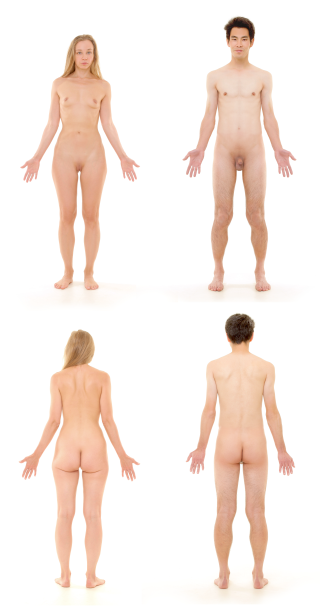
The human body is the entire structure of a human being. It is composed of many different types of cells that together create tissues and subsequently organs and then organ systems. They ensure homeostasis and the viability of the human body.

The urinary system, also known as the urinary tract or renal system, consists of the kidneys, ureters, bladder, and the urethra. The purpose of the urinary system is to eliminate waste from the body, regulate blood volume and blood pressure, control levels of electrolytes and metabolites, and regulate blood pH. The urinary tract is the body's drainage system for the eventual removal of urine. The kidneys have an extensive blood supply via the renal arteries which leave the kidneys via the renal vein. Each kidney consists of functional units called nephrons. Following filtration of blood and further processing, wastes exit the kidney via the ureters, tubes made of smooth muscle fibres that propel urine towards the urinary bladder, where it is stored and subsequently expelled from the body by urination. The female and male urinary system are very similar, differing only in the length of the urethra.
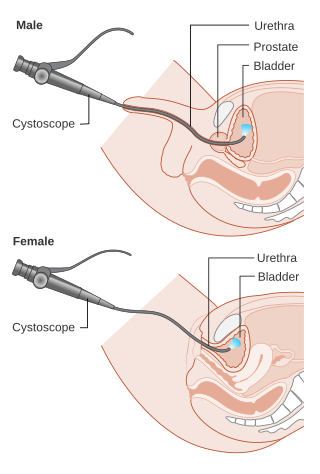
Cystoscopy is endoscopy of the urinary bladder via the urethra. It is carried out with a cystoscope.
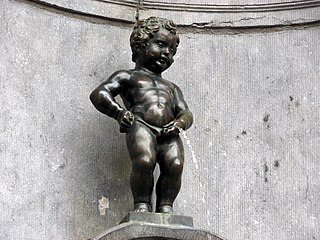
Urination is the release of urine from the bladder through the urethra to the outside of the body. It is the urinary system's form of excretion. It is also known medically as micturition, voiding, uresis, or, rarely, emiction, and known colloquially by various names including peeing, weeing, pissing, and euphemistically going number one. In healthy humans and other animals, the process of urination is under voluntary control. In infants, some elderly individuals, and those with neurological injury, urination may occur as a reflex. It is normal for adult humans to urinate up to seven times during the day.
In anatomy, a meatus is a natural body opening or canal.
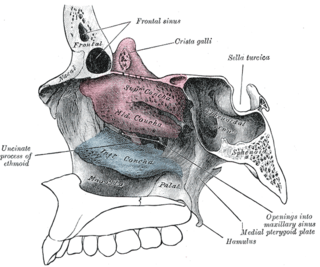
In anatomy, a nasal concha, also called a nasal turbinate or turbinal, is a long, narrow, curled shelf of bone that protrudes into the breathing passage of the nose in humans and various animals. The conchae are shaped like an elongated seashell, which gave them their name. A concha is any of the scrolled spongy bones of the nasal passages in vertebrates.
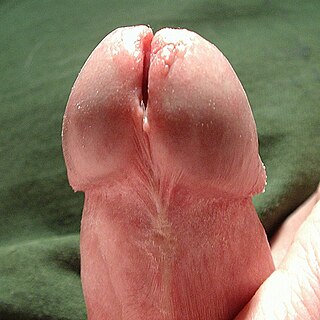
A meatotomy is a form of penile modification in which the underside of the glans is split, extending the urinary meatus. The procedure may be performed by a doctor to alleviate meatal stenosis or urethral stricture.
The urogenital opening is where bodily waste and reproductive fluids are expelled to the environment outside of the body cavity. In some organisms, including birds and many fish, discharge from the urological, digestive, and reproductive systems empty into a common sac called the cloaca.
Urethral meatal stenosis is a narrowing (stenosis) of the opening of the urethra at the external meatus, thus constricting the opening through which urine leaves the body from the urinary bladder.
The development of the urinary system begins during prenatal development, and relates to the development of the urogenital system – both the organs of the urinary system and the sex organs of the reproductive system. The development continues as a part of sexual differentiation.

The trigone is a smooth triangular region of the internal urinary bladder formed by the two ureteric orifices and the internal urethral meatus.

The tympanic cavity is a small cavity surrounding the bones of the middle ear. Within it sit the ossicles, three small bones that transmit vibrations used in the detection of sound.

The abdomen is the part of the body between the thorax (chest) and pelvis, in humans and in other vertebrates. The abdomen is the front part of the abdominal segment of the torso. The area occupied by the abdomen is called the abdominal cavity. In arthropods, it is the posterior tagma of the body; it follows the thorax or cephalothorax.
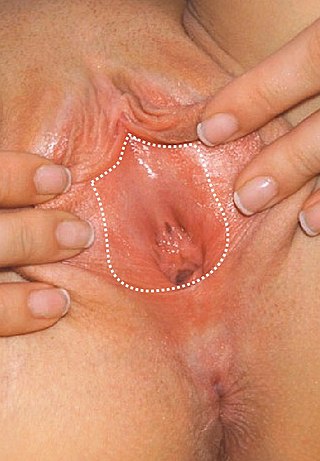
The vulval vestibule is the part of the vulva between the labia minora. On the inside, the urinary meatus and the vaginal opening open to the vestibule, while the outer edge is marked by Hart's line, named after David Berry Hart.

The spongy urethra is the longest part of the male urethra, and is contained in the corpus spongiosum of the penis.
Urethral orifice can refer to:
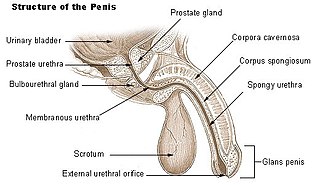
The urinary meatus, also known as the external urethral orifice, is the opening of the urethra. It is the point where urine exits the urethra in both sexes and where semen exits the urethra in males. The meatus has varying degrees of sensitivity to touch. The meatus is located on the glans of the penis or in the vulval vestibule.